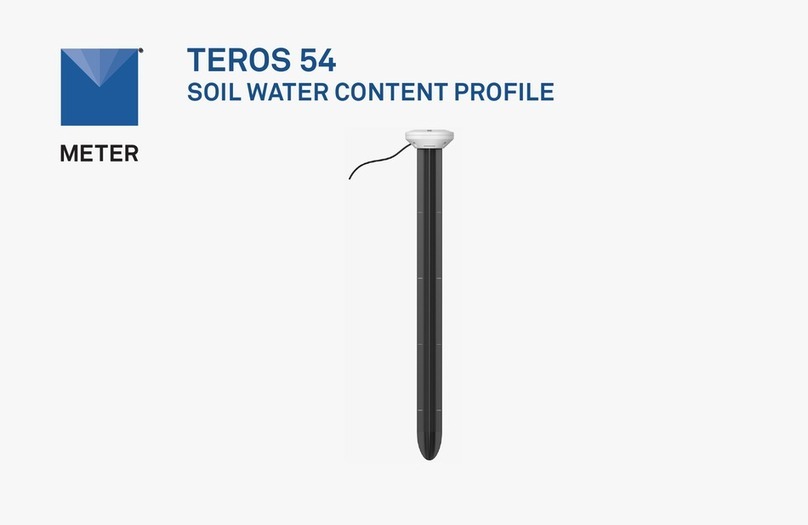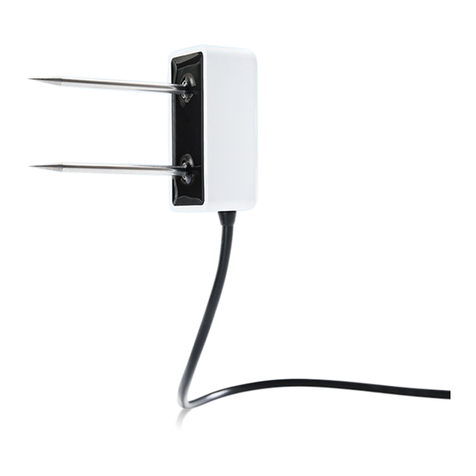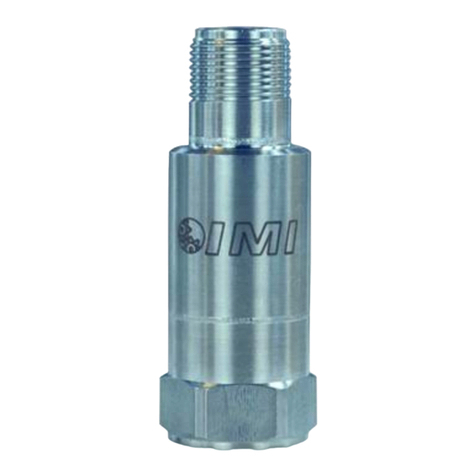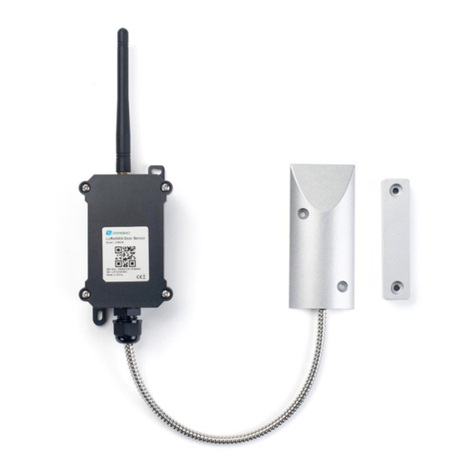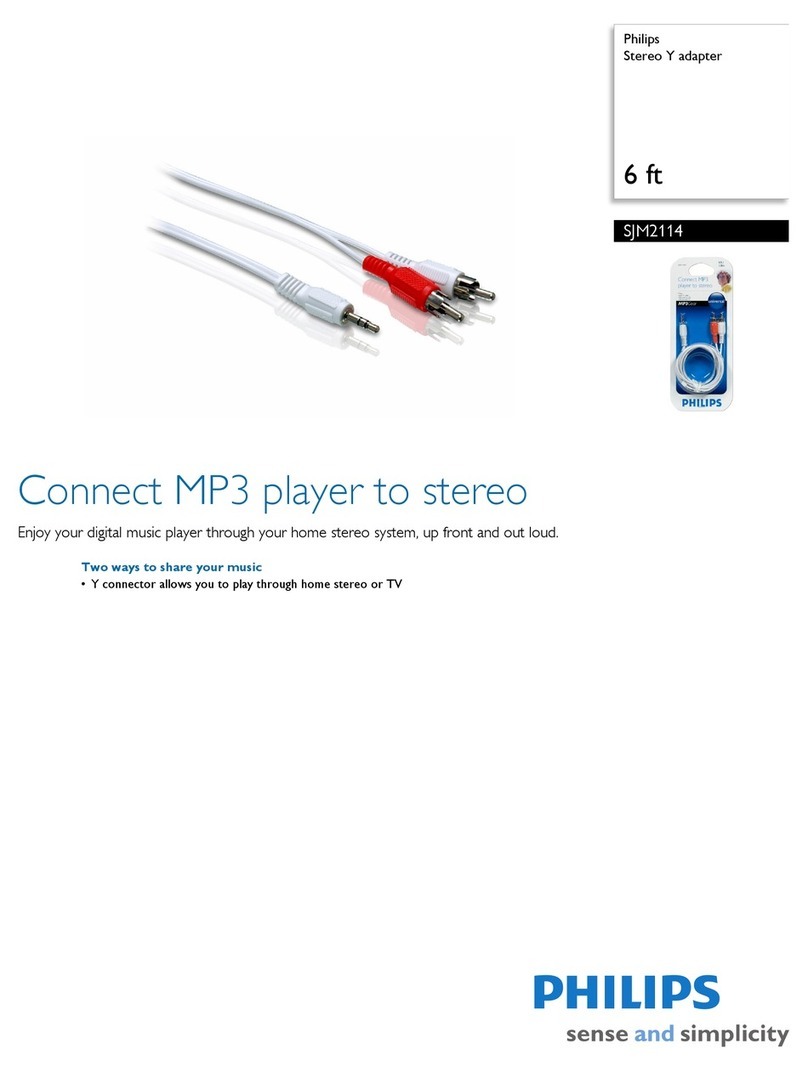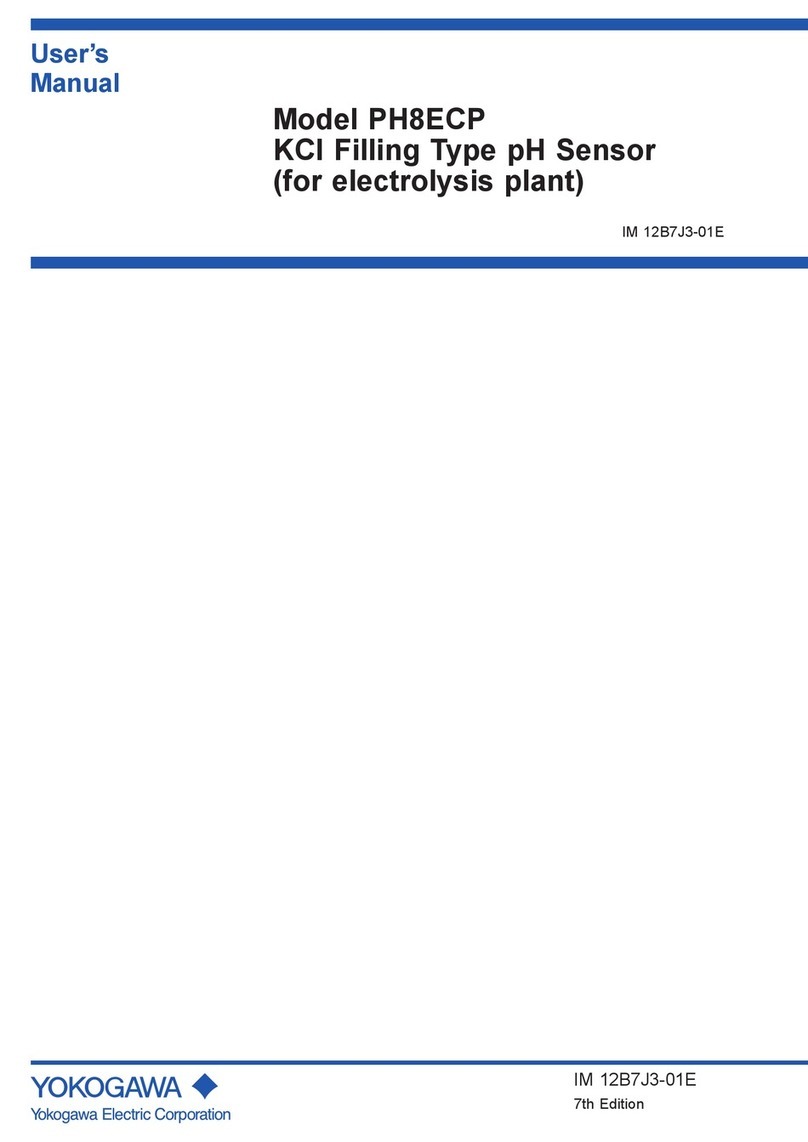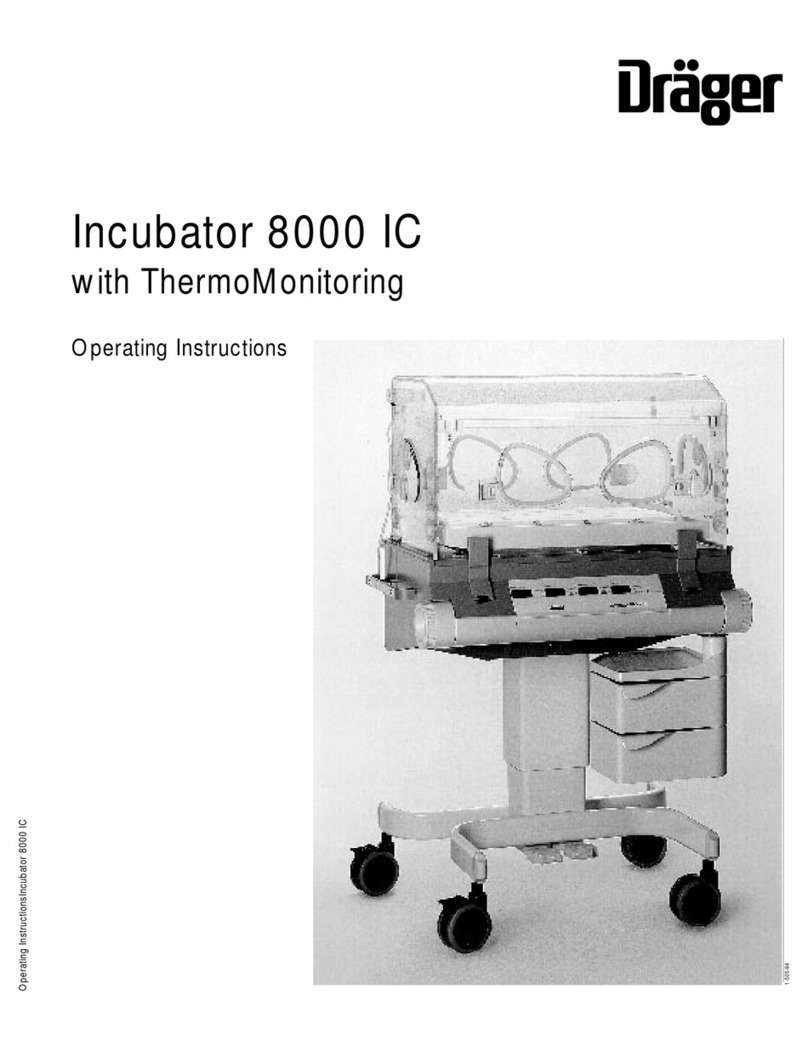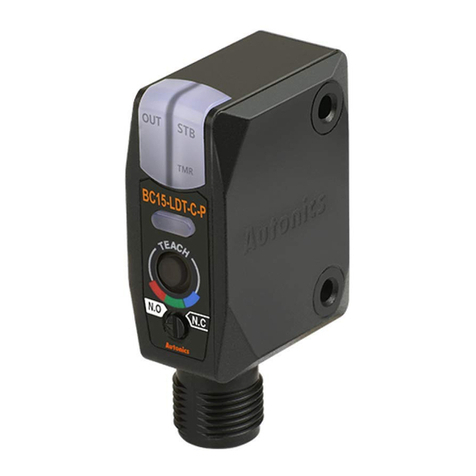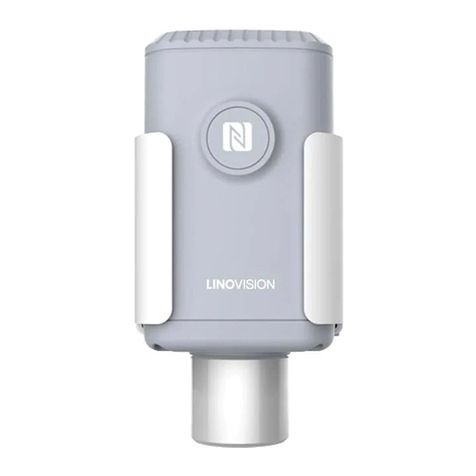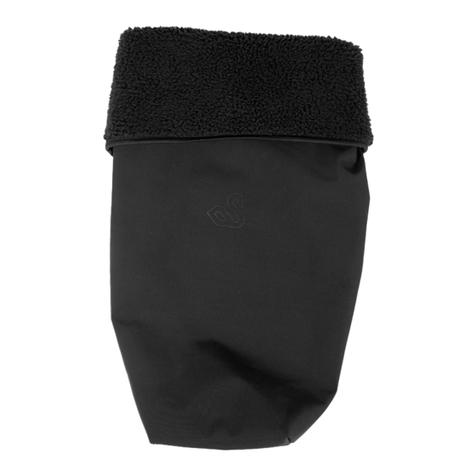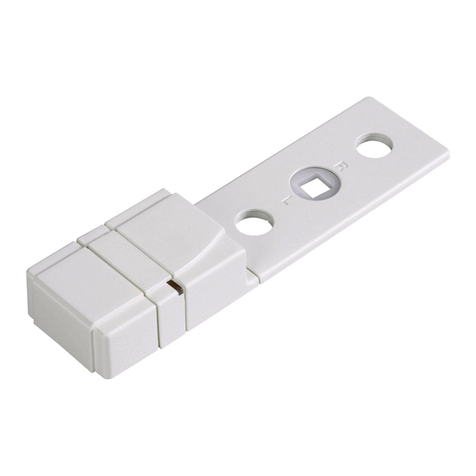METER TEROS 21 User manual

TEROS 21


i
TABLE OF CONTENTS
1. Introduction..............................................................................................1
2. Operation ................................................................................................... 2
2.1 Installation ................................................................................................2
2.2 Connecting................................................................................................. 3
3. System.........................................................................................................6
3.1 Specifications............................................................................................6
3.2 Components ..............................................................................................9
3.3 Theory........................................................................................................9
3.3.1 Water Potential Measurement .........................................................9
3.3.2 Measurement Range...................................................................... 10
3.3.3 Measurement Accuracy ................................................................. 12
3.3.4 Temperature Measurement............................................................ 13
3.4 Considerations......................................................................................... 13
3.4.1 Measuring in Frozen Soils.............................................................. 13
3.4.2 Measuring in High Salinity ............................................................. 14
3.4.3 Temperature Sensitivity................................................................. 14
4. Service....................................................................................................... 15
4.1 Calibration ............................................................................................... 15
4.2 Maintenance............................................................................................ 15
4.3 Troubleshooting....................................................................................... 16
4.4 Customer Support.................................................................................... 16
4.5 Terms and Conditions .............................................................................. 17
References .................................................................................................... 19
Index ................................................................................................................. 20
13755-03
11.10.2017


1
TEROS 21
1. INTRODUCTION
Thank you for purchasing the TEROS 21 Soil Water Potential Sensor from METER Group.
TEROS 21 was designed to be a maintenance-free matric potential sensor designed for long-
term, continuous field measurements. The TEROS 21 measures the dielectric permittivity of
a solid matrix to determine the water content of the solid matrix. The relationship between
water content and matric potential, known as the soil moisture characteristic curve, is used
to calculate the soil matric potential. This measurement approach, along with the calibration
process used in production, allows for accurate measurements of water potential.
Prior to use, verify the TEROS 21 arrived in good condition.

2
OPERATION
2. OPERATION
Please read all instructions before operating the TEROS 21 to ensure it performs to its
full potential.
SAFETY PRECAUTIONS
METER sensors are built to the highest standards, but misuse, improper protection, or
improper installation may damage the sensor and possibly void the manufacturer’s warranty.
Before integrating TEROS 21 into a system, follow the recommended installation instructions
and have the proper protections in place to safeguard sensors fromdamage.
2.1 INSTALLATION
Follow the steps listed in Table 1 to set up the sensor. It is critical that the sensor has good
hydraulic contact with the soil to make accurate measurements.
Table 1 Installation
Tools Needed
Auger or shovel
Knife (if installing in shallow depth)
Water (for packing soil or making slurry)
Preparation
Check Sensor Functionality
Plug the sensor into the logger (Section 2.2) to make sure the sensor
isfunctional.
Field Installation
Create Hole
Auger or trench a hole to the desired sensor depth.
Pack Sensor
Moisten native soil and pack it rmly around the entire sensor discs. Ensure
the soil is in contact with all surfaces of the ceramic.
NOTE: Sandy soils may not adhere to the sensor even when wet. If so, place the sensor at
the bottom of the hole and carefully pack the soil around the sensor. Be sure to pack the
soil firmly around ceramic surfaces.

3
TEROS 21
Table 1 Installation (continued)
Field Installation
(continued)
Install Sensor
For shallow installation (less than ~30 cm), use a knife to remove a small sliver
of soil. Insert packed sensor into the channel.
For deep installation (greater than ~30 cm), use the native soil to make a slurry
with water. Lower sensor into the hole and ll with the slurry.
NOTE: Soils with high shrink-swell potential may pull away from the sensor as they dry
and disrupt measurements.
NOTE: Do not install the sensor with the body exposed above ground.
Connect to Logger
Leave at least 15 cm (6 in) of sensor cable beneath the soil before bringing the
cable to the surface. At least 10 cm (4 in) of cable should exit the sensor body
in a straight line before bending the cable.
Plug the sensor into the logger.
Use the data logger to make sure the sensor is reading properly.
Return soil to the hole, packing the soil back to its native bulk density.
2.2 CONNECTING
The TEROS 21 sensors work best with METER data loggers or ProCheck handheld readers.
1. Check data logger software and firmware versions to ensure they support
TEROS21 sensors (http://www.metergroup.com/teros21-support/).
Plug the stereo plug connector directly into one of the sensor ports.
2. Congure the logger port for TEROS 21 using the appropriate logger application.
The TEROS 21 sensors have a 5-m cable. Customers may purchase custom cable lengths
for an additional per-meter fee. If the cable needs to be extended, ensure to adequately
waterproof the cable splices to prevent a major failure point. Read Wire splicing and sealing
technique for soil moisture sensors for more information.
The sensor uses a 3.5-mm stereo plug connector (Figure1). Customers may purchase the
sensor with stripped and tinned wires (pigtail) for terminal connections for third-party data
loggers (Figure2). Refer to the individual third-party logger manual for details on wiring.
NOTE: The acceptable range of power voltages is from 3.9 to 15.0 VDC, with 12 VDC being the optimal voltage.
Ground
Data
Power
3.5-mm stereo plug connector

4
OPERATION
Ground (bare)
Data (orange)
Power (brown)
Pigtail wiring
NOTE:Sensors manufactured as MPS-6 use white wire for power and red wire for data output.
TEROS 21 sensors communicate using two different methods: serial (TTL) and SDI-12.
Please refer to the complete TEROS 21 Integrator Guide for more detailed explanations
andinstructions.
There are two options to connect a sensor with the standard stereo plug to a non-METER
data logger.
Option 1
1. Clip the plug off the sensor cable.
2. Strip and tin the wires.
3. Connect the wires directly into the data logger.
This will create a direct connection with no chance of the sensor becoming unplugged;
however, the sensor cannot be easily used in the future with a METER readout unit or
datalogger.
Option 2
Obtain an adapter cable from METER.
The adapter cable has a 3.5-mm stereo plug connector for connecting to the sensor on one
end and three wires for connecting to a data logger (a stereo-to-pigtail adapter) on the other
end. The stripped and tinned adapter cable wires have the same termination as seen in
Figure2; the brown wire is power, orange is output, and the bare wire is ground.
Because TEROS 21 sensors use digital communication, they require special considerations
when connecting to an SDI-12 data logger. Read SDI-12 example programs to view sample
Campbell Scientific programs.

5
TEROS 21
The SDI-12 protocol requires that all sensors have a unique address. TEROS 21 sensors
factory default is an SDI-12 address of 0. To add more than one SDI-12 sensor to a bus, the
sensor address must be changed as described below:
1. Using a ProCheck connected to the sensor, press the Menu button to bring up the
CONFIGmenu.
NOTE: If the ProCheck does not have this option, please upgrade its firmware to the latest version from the METER
Legacy Handheld Devices webpage.
2. Scroll down to SDI-12 Address. Press Enter.
3. Press the UP or DOWN arrows until the desired address is highlighted.
Address options include 0...9, A…Z, and a…z.
4. Press Enter.
Detailed information can also be found in the application note Setting SDI-12 addresses on
METER digital sensors using Campbell Scientific data loggers and LoggerNet.
When using the sensor as part of an SDI-12 bus, excite the sensors continuously to avoid
issues with initial sensor startup interfering with the SDI-12 communications.
SDI-12 communication can convey multiple parameters from a single function call. In the
data stream, TEROS 21 reports (1) the sensor address, (2) the water potential (in kilopascals),
and (3) the temperature (in Celsius).

6
SYSTEM
3. SYSTEM
This section reviews the components and functionality of the TEROS 21 sensor.
3.1 SPECIFICATIONS
Water Potential
Range: −9 to −100,000 kPa (1.96 to 6.01 pF)
Resolution: 0.1 kPa
Accuracy: ±(10% of reading + 2 kPa) from −9 to −100 kPa
Temperature
Range: −40 to 60 °C
Resolution: 0.1 °C
Accuracy: ±1 °C
Operating Temperature
−40 to 60 °C (0%–100% RH)
No water potential measurement <0 °C
NOTE: Sensors may be used at higher temperatures under certain conditions; contact Customer Support
Power Requirements
3.9 to 15.0 VDC, 0.03 mA quiescent, 10 mA max during 150-ms measurement
Dimensions
9.6 cm × 3.5 cm × 1.5 cm
Sensor Diameter
3.2 cm
Dielectric Measurement Frequency
70 MHz
Measurement Time
150 ms

7
TEROS 21
Output
RS232 (TTL) with 3.9-VDC levels or SDI-12 communication protocol
Connector Types
3.5-mm stereo plug connector or stripped and tinned wires
Cable Length
5 m (standard)
75 m (maximum custom cable length)
Data Logger Compatibility
Any data acquisition system capable of 3.9- to 15.0-VDC power and serial or
SDI-12 communication
Supply Voltage (VCC) to GND
Minimum 3.6 VDC
Typical
Maximum 15.0 VDC
Digital Input Voltage (logic high)
Minimum 2.8 V
Typical 3.6 V
Maximum 3.9 V
Digital Input Voltage (logic low)
Minimum –0.3 V
Typical 0.0 V
Maximum 0.8 V
Power Line Slew Rate
Minimum 1.0 V/ms
Typical
Maximum

8
SYSTEM
Current Drain (during measurement)
Minimum 3.0 mA
Typical 3.6 mA
Maximum 10.0 mA
Current Drain (while asleep)
Minimum
Typical 0.03 mA
Maximum
Operating Temperature Range
Minimum –40 °C
Typical
Maximum 50 °C
Power Up Time (DDI serial)
Minimum
Typical
Maximum 100 ms
Power Up Time (SDI-12)
Minimum 100 ms
Typical 150 ms
Maximum 200 ms
Measurement Duration
Minimum
Typical 150 ms
Maximum 200 ms
Compliance
Manufactured under ISO 9001:2015
EM ISO/IEC 17050:2010 (CE Mark)

9
3.2 COMPONENTS
The TEROS 21 sensor measures the water potential and temperature of soil with porous
ceramic discs (Figure3). TEROS 21 sensors measure moisture content changes of two
engineered ceramic discs sandwiched between stainless steel screens and the circuit
board. These sensors have a low power requirement, which makes them ideal for permanent
burial in the soil and continuous reading with a data logger or periodic reading with a
handheldreader.
Vinyl lled with
polurethane resin
Grounded stainless
steel screen
Ceramic disc
(static matrix)
Printed circuit
board
Sensor body
Sensor head
TEROS 21 sensor
3.3 THEORY
TEROS 21 sensors measure water potential, so they are not as sensitive to soil disturbance
as water content sensors. TEROS 21 need good hydraulic contact with the surrounding soil
for accurate measurements.
3.3.1 WATER POTENTIAL MEASUREMENT
All soil water potential measurement techniques measure the potential energy of water in
equilibrium with water in the soil. The Second Law of Thermodynamics states that connected
systems with differing energy levels move toward an equilibrium energy level. When an
object comes into hydraulic contact with the soil, the water potential of the object comes
into equilibrium with the soil water potential.
TEROS 21 uses a solid matrix equilibration technique to measure the water potential of
the soil. This technique introduces a material with a known pore size distribution into
the soil and allows it to come into hydraulic equilibrium according to the Second Law of
Thermodynamics. Because the two are in equilibrium, measuring the water potential of the
solid matrix gives the water potential of the soil.

10
SYSTEM
TEROS 21 measures the dielectric permittivity of a solid matrix (porous ceramic discs)
to determine its water potential. The dielectric permittivity of air, the solid ceramic,
and water are 1, 5, and 80, respectively. So, the dielectric permittivity of the porous
ceramic discs is highly dependent on the amount of water present in the pore spaces.
Measuring the dielectric permittivity of the ceramic discs resolves a wide range of water
contentmeasurements.
Water content and water potential are related by a relationship unique to a given material,
called the moisture characteristic curve. The ceramic used with the TEROS 21 has a wide
pore size distribution and is consistent between discs, giving each disc the same moisture
characteristic curve. Thus, the water potential can be inferred from water content using the
moisture characteristic curve of the ceramic
Equation 1 gives the component variables for determining total soil water potential(Ψt ):
Equation 1
pg mt
WWWWW
=+++
o
where Ψ
pis pressure, Ψ
gis gravitational, Ψ
ois osmotic, and Ψ
mis matric.
For TEROS 21 applications, Ψ
pand Ψ
gare generally insignificant. Ψ
oarises from dissolved
salts in the soil and only becomes important if a semipermeable barrier is present that
prevents ionic movement (e.g., plant roots or cell membranes). Ψ
marises from the attraction
of water to the soil particles and is the most important component of water potential in most
soils. TEROS 21 responds to the matric potential of the soil (Ψ
m ). In highly salt-affected soils,
it may be necessary to quantify Ψ
oindependently if the measurements of soil water potential
are related to biological activity (Section 3.4.2).
3.3.2 MEASUREMENT RANGE
TEROS 21 measures the water content of porous ceramic discs and converts the measured
water content to water potential using the moisture characteristic curve of the ceramic.
Therefore, it is important that the ceramic discs drain over a wide water potential range.
Pore size determines the water potential at which a pore drains (the air entry potential
or bubble pressure), so the ideal ceramic would have pores that range from very small to
relatively large. METER designed the ceramic discs to approach this ideal (Figure4). The
discs have a total pore volume that is weighted toward the larger pores, which drain at water
potentials within the plant-available range (approximately −33 to −1,500 kPa). However, the
TEROS21 measurement range extends all the way to air dry (−100,000 kPa).

11
TEROS 21
0.000
0.100
0.200
0.300
0.400
0.500
0.600
0.700
0.800
0.900
1.000
110100 1,00010,00
01
00,000
WATER POTENTIAL (-kPa)
GRAVIMETRIC WATER CONTENT
Moisture characteristic curve of TEROS 21 ceramic derived from mercury porosimeter data
As the sensor dries past the plant-available range, the total pore volume that drains at
a given water potential decreases. At these low water potentials, the measured water
potential can become somewhat noisy because small changes in measured water content
of the ceramic translate into large changes in water potential. This phenomenon is most
pronounced when the sensor is air dry. It is expected that the measured water potential of an
open air and dry sensor can jump around throughout the range of −50,000 to −100,000 kPa.
The noise level is much lower when the sensor is installed in the soil, even at air-dry
waterpotential.
The air entry potential of the largest pores in the ceramic is about −9 kPa. However, the
ceramic disc must have access to air for the large pores to begin draining and the response
of the sensor to change. If the soil around the sensor has an air entry potential lower (drier)
than −9 kPa, the ceramic will not begin to lose water until reaching the air entry potential
of the soil. In this scenario, the air entry potential of the soil limits the wet-end range,
rather than the ceramic discs themselves. The sensor may not begin to respond until lower
water potentials (−10 kPa). This is generally only an issue when using the sensor in poorly
structured soils with high clay content.

12
SYSTEM
3.3.3 MEASUREMENT ACCURACY
TEROS 21 is calibrated at a saturated state (0 kPa), at an air-dry state (−100,000 kPa), and at
three calibration points between 0 and −100 kPa, resulting in accuracy of ±(10% of reading +
2 kPa) over the range of −9 to −100 kPa.
At water potentials drier than −100 kPa, TEROS 21 relies on the linear relationship between
the logarithm of water content and the logarithm of water potential. Laboratory evaluations
have shown good accuracy and low sensor-to-sensor variability to at least −1,500 kPa (plant
permanent wilting point). Field evaluations have shown low sensor-to-sensor variability to
−2,000 kPa (Figure5 and Figure6).
NOTE:METER strongly discourages dry-end calibrations in the pressure plate apparatus. Early attempts to improve
sensor dry-end performance in the pressure plate apparatus actually decreased accuracy, likely because of pressure
plate dry-end equilibrium issues pointed out in the literature (e.g., Campbell [1998], Gee et al. [2002], Bittelli and Flury
[2009], and Frydman and Baker [2009]).
−2,000.0
−1,500.0
−1,000.0
−500.0
0.0
SOIL WATER POTENTIAL (kPa)
TIME (DAYS)
020 40 60 80
Sensor 1
Sensor 2
Sensor 3
Permanant wilting point
Time series TEROS 21 water potential data collected at 80 cm depth
under a beech forest in Switzerland (Walthert, 2013). Note the good sensor

13
TEROS 21
−2,000.0
−1,500.0
−1,000.0
−500.0
0.0
−2,500.0
−3,000.0
−3,500.0
−4,000.0
−4,500.0
020 40 60 80
TIME (DAYS)
SOIL WATER POTENTIAL (kPa)
Sensor 1
Sensor 2
Permanant wilting point
Time series TEROS 21 water potential data collected at 20 cm under a dry oak forest in
Switzerland (Walthert 2013). Note the range extends well beyond permanent wilting point.
3.3.4 TEMPERATURE MEASUREMENT
TEROS 21 uses a surface-mounted thermistor to take temperature readings. The thermistor
is located underneath the sensor epoxy. The TEROS 21 output temperature readings in
degrees Celsius unless otherwise stated in preference settings in METER software programs.
If the black plastic body of the sensor is exposed to solar radiation, the temperature
measurement may read high. Exposure of the body also drastically decreases the life
expectancy of the sensor. Do not install the sensor with the body above ground.
3.4 CONSIDERATIONS
TEROS 21 sensors use similar technology to METER water content sensors and are
susceptible to the same constraints. Using TEROS 21 in certain environments will require
additional considerations.
3.4.1 MEASURING IN FROZEN SOILS
TEROS 21 measures the dielectric permittivity of two ceramic discs to measure their water
content and then derive their water potential. The dielectric permittivity of water in the
ceramic discs is 80 compared to a dielectric permittivity of ~5 for the ceramic material or
1 for air. When water freezes to ice, the dielectric permittivity drops to 5 at the frequency
of the sensor measurement, meaning that the sensor can no longer accurately measure
the water in the ceramic. TEROS 21 does not accurately measure water potential in frozen
soil conditions. However, the water potential of the soil under frozen soil conditions can be

14
SYSTEM
estimated by measuring the soil temperature accurately (Koopmans and Miller, 1966). For
each 1 °C decrease in temperature below 0 °C, the water potential in the soil decreases by
~1,200 kPa. Spaans and Baker (1996) showed that this relationship is valid in field soils for
water potentials below about −50 kPa.
Rigorous testing indicates that repeated freeze–thaw cycles do not affect the ceramic discs.
Several sensors were equilibrated in saturated soil and then subjected to numerous freeze–
thaw cycles in a temperature-controlled chamber. The freezing rate of the soil containers
was at least an order of magnitude faster than could be achieved in field soils under natural
conditions. At several points during the test, and at the end of the test, the ceramic discs
were evaluated for damage due to repeated rapid freezing of pore spaces full of water. None
of the ceramic discs showed any signs of physical damage, and none of the sensors showed
any significant change in output due to the freeze–thaw tests.
3.4.2 MEASURING IN HIGH SALINITY
A saturation extract electrical conductivity (EC) greater than 10 dS/m will confound the
capacitance measurement taken by the sensor resulting in erroneous matric potential
readings. It is recommend that the TEROS 21 only be used in environments where the
saturation extract EC does not exceed 10 dS/m.
3.4.3 TEMPERATURE SENSITIVITY
Fluctuations in temperature can affect the capacitance readings at matric potential less
than about −500 kPa (Figure7). Although temperature can affect the output of the reading,
the nature of the moisture retention curve of the ceramic results in an extremely small effect
on matric potential until the substrate dries out to about −500 kPa. A small change in water
content can result in a relatively large change in matric potential beyond −500 kPa.
−1,800.0
−1,600.0
−1,400.0
−1,200.0
−1,000.0
−800.0
−600.0
−400.0
−200.0
0.0
010203040506070
WATER POTENTIAL (kPa)
Sensor 1 (5-cm depth)
Sensor 2 (15-cm depth)
TIME (DAYS)
Temperature sensitivity data for TEROS 21 sensors

15
TEROS 21
4. SERVICE
This section describes the calibration and maintenance of TEROS 21. Troubleshooting
solutions and customer service information are also provided.
4.1 CALIBRATION
TEROS 21 calibration is not affected by soil type because the sensors only measure the
water potential of the ceramic discs in equilibrium with the soil. TEROS 21 works in any
soil type or other porous media as long as it is installed correctly with adequate hydraulic
contact (to ensure timely water potential equilibrium between the sensor and the medium
ofinterest).
The amount of water that a soil holds at a given water potential is greater if the material
is dried to that water potential than if the material is wet up to that water potential; a
phenomenon known as hysteresis. Because TEROS 21 essentially makes a dielectric
measurement of water content and converts that to water potential, sensor measurements
have some hysteresis. In most situations, soil undergoes brief periods of wet up
(precipitation or irrigation events) followed by longer dry down periods, where water
potential measurements are most useful. METER performs TEROS 21 calibration on the
drying leg of the hysteresis loop, so the measurements are most accurate as the soil dries.
Measurements as the soil wets up are slightly drier (more negative water potential) than the
true water potential of the soil. METER wetting and drying tests show the magnitude of the
hysteresis error is <10 kPa in the −20 to −100 kPa range.
4.2 MAINTENANCE
TEROS 21 may be returned to METER for maintenance in the following areas: system
inspection, parts replacement, and instrument cleaning. Replacement parts can also be
ordered from METER. Contact Customer Support for more information.
The ceramic discs are brittle and can chip or crack if abused. The metal screens afford the
discs some amount of protection, but sharp trauma on the disc edges or massive impact
(such as dropping the sensor onto a hard surface) can cause the ceramic to break. One or two
small chips on the edge of the disc do not affect the sensor accuracy significantly. However,
a cracked ceramic disc results in a loss of accuracy.
For TEROS 21 to accurately measure water potential, the ceramic discs must readily take
up water. Exposure to oils or other hydrophobic substances compromises the ability of the
discs to take up water from the soil. This inability to take up water leads to slow equilibration
times and loss of accuracy. Minimize exposure of the ceramic material to skin oils, grease,
synthetic oils, or other hydrophobic compounds.

16
SERVICE
4.3 TROUBLESHOOTING
Table 2 lists common problems and their solutions. Most issues with the TEROS 21 sensor
will manifest themselves in the form of incorrect or erroneous readings. If the problem is not
listed or these solutions do not solve the issue, contact Customer Support.
Table 2 Troubleshooting TEROS 21
Problem Possible Solutions
Data logger is not
recognizing sensor If using a METER logger, update logger rmware.
Data logger is not receiving
readings from the sensor
Check to make sure the connections to the data logger are both
correct and secure.
Ensure that your data logger batteries are not dead or weakened.
Check conguration of data logger through software to ensure
TEROS21 is selected.
Ensure the software and rmware is up to date.
Sensor does not appear to
be responding to changes
in soil water potential
Ensure that sensors are installed correctly.
Check sensor cables for damage that could cause a malfunction.
Check the ceramic disc for damage or contamination.
4.4 CUSTOMER SUPPORT
Customer service representatives are available for questions, problems, or feedback Monday
through Friday, 8 am–5 pm Pacific time.
Email: support.environment@metergroup.com
sales.environment@metergroup.com
Phone: +1.509.332.5600
Fax: +1.509.332.5158
Website: www.metergroup.com
If contacting METER by email or fax, please include the following information:
Name
Address
Phone
Email address
Instrument serial number
Description of the problem
NOTE: For TEROS 21 Soil Water Potential sensors purchased through a distributor, please contact the
distributor directly for assistance.
Other manuals for TEROS 21
1
Table of contents
Other METER Accessories manuals
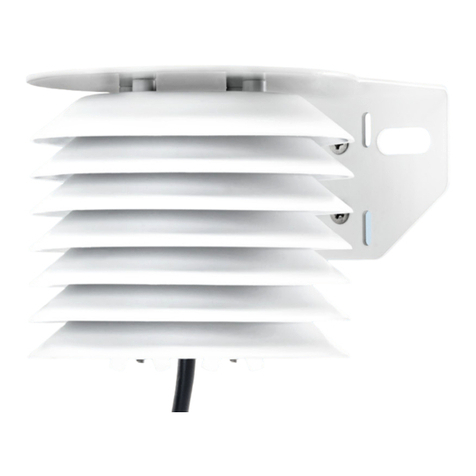
METER
METER ATMOS 14 User manual

METER
METER TEROS 11 Assembly Instructions
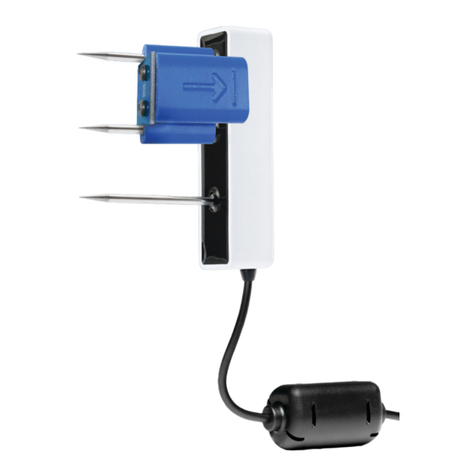
METER
METER TEROS VERIFICATION CLIP User manual

METER
METER ATMOS 14 User manual

METER
METER TEROS 10 User manual

METER
METER HYDROS 21 GEN 1 User manual
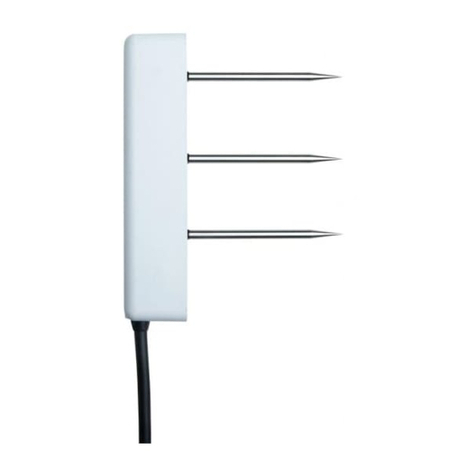
METER
METER TEROS 11 User manual

METER
METER TEROS 12 User manual

METER
METER ATMOS 14 User manual
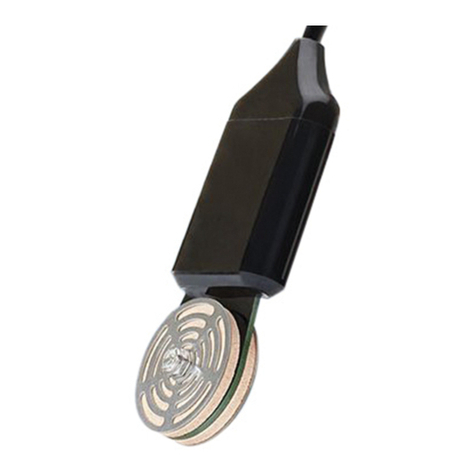
METER
METER TEROS 21 Assembly Instructions
Popular Accessories manuals by other brands
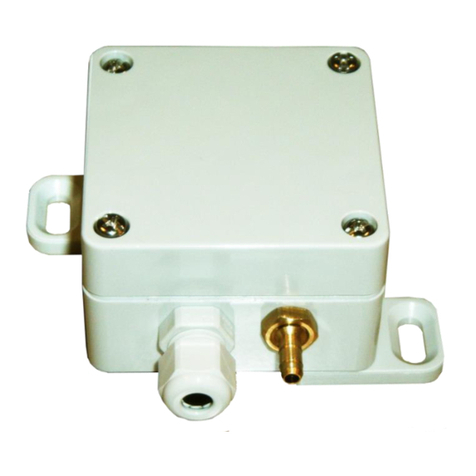
Sutron
Sutron Accubar 5600-0120-3 Operation and maintenance manual

Broan
Broan NuTone Overture 1110725 manual

Daga
Daga Flexy-Heat CIN Comfort Directions for use
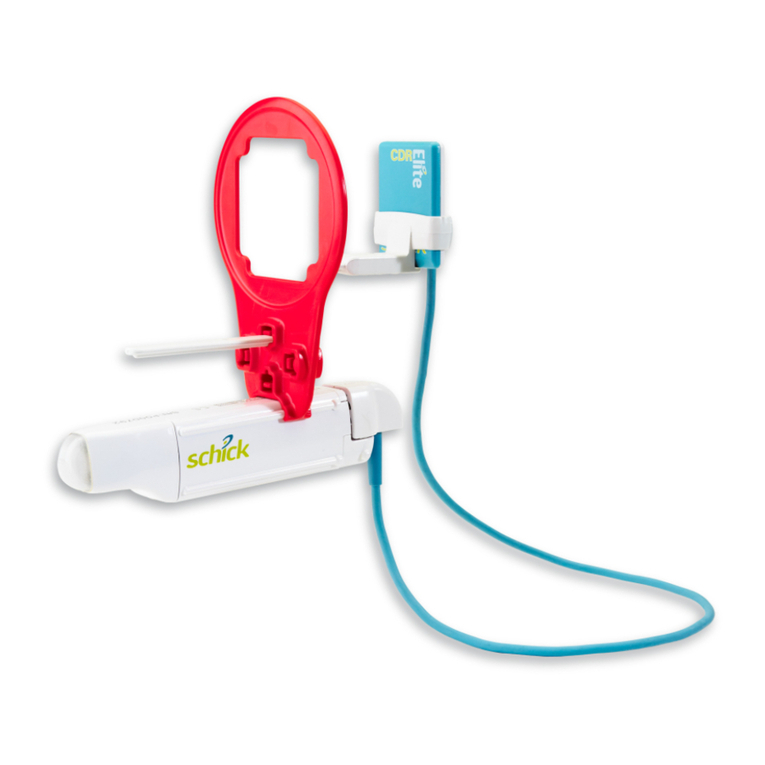
Schick
Schick WiFi Battery Replacement
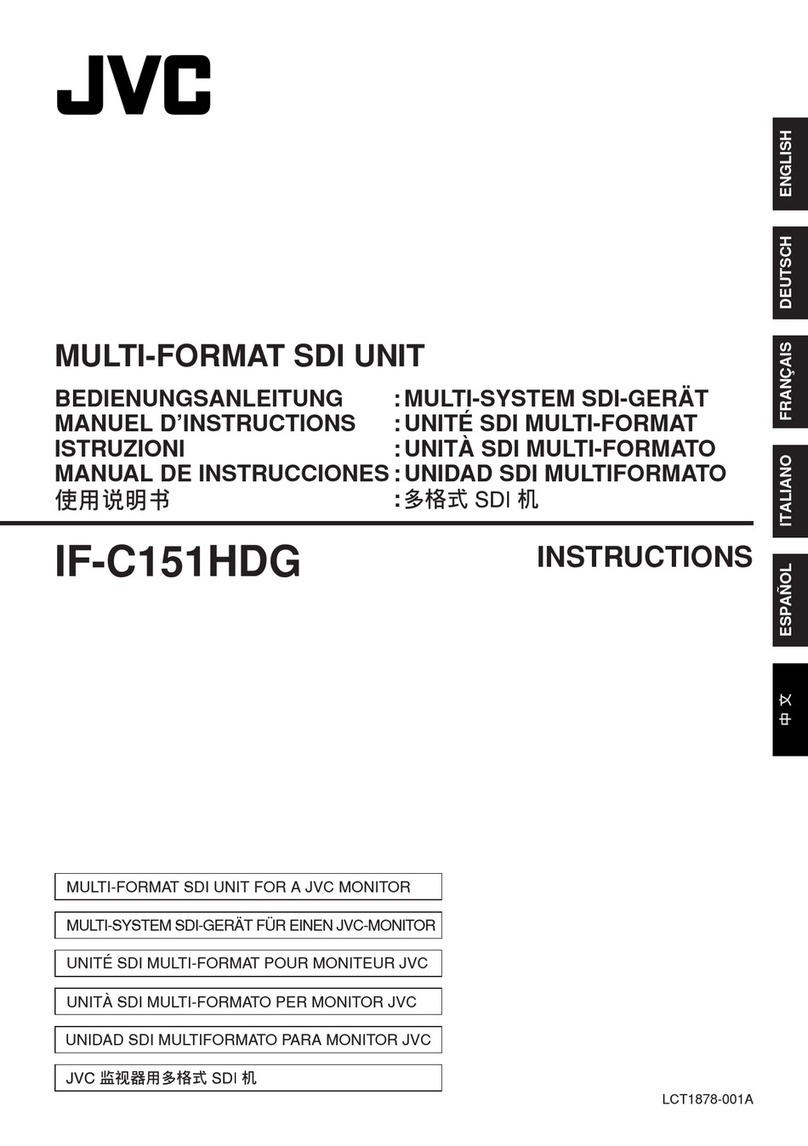
JVC
JVC Multi-Format SDI Unit IF-C151HDG instructions
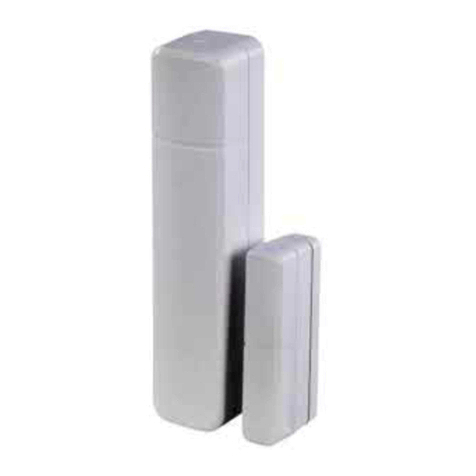
resideo
resideo PROSIXCT-EU Installation and setup guide
